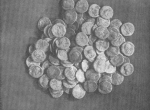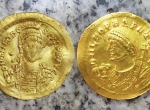Gąski
Gąski in distr. Inowrocław, in Kuyavia, the site of a large settlement complex dating to the Pre-Roman, the Roman and the →Migration periods known to extend to the nearby localities of Parchanki and Wierzbiczany. One of the sites belonging to the settlement complex – Gąski site 18 – was investigated in 1984-1989 by a team of archaeologists from the Institute of Prehistory, Adam Mickiewicz University in Poznań, headed by Aleksandra Cofta-Broniewska. Next to archaeological materials attributed to the →Przeworsk Culture the fieldwork yielded evidence on Neolithic, early Bronze Age and early medieval period (final phase) occupation.
During the Pre-Roman Period and the Roman Period the hill (Gąski, site 18) was a burial ground. As in other cemeteries known from the Inowrocław region, next to cremation there were also inhumation burials. During the Late Roman Period the cemetery was succeeded by a settlement, documented by the remains of 4 dwellings, 19 storage pits and 34 postholes. The prosperity of the inhabitants is documented by a rich inventory of portable finds, more notably, imported glass vessels, and a few dozen lumps of raw amber. One house (feature no. 104) yielded evidence on local amberworking. A deposit of 140 Roman denarii (Fig. 1) discovered by the corner of this feature reportedly consisted of coins struck during the second half of the 2nd and early into the 3rd century. To this day these materials await analysis and publication and are known only from summary reports.
For some time now news about a vast quantity of archaeological objects recovered by amateurs (some of them treasure hunters) in the region of Gąski and Wierzbiczany has been reaching the research community. These finds, invaluable for improving our understanding of the Iron Age settlement centre, include Celtic coins (about 100), mostly struck locally, Roman coins (more than 1000), a few hundred (?) fragments of brooches, and other objects – most of them dating to the Late Roman Period and the →Migration Period. Although the latest of the recorded Roman coins date from the 4th century, the presence of brooches and their intermediate specimens in the finds assemblage confirms the continued presence of a Germanic population in the region of Gąski and Wierzbiczany during the 5th century, possibly as late as the 6th.
MR
Literature: upublished research, cf. A. Cofta-Broniewska, B. Stolpiak, M. Andrałojć, Gąski, gm. Gniewkowo, woj. bydgoskie. Stanowisko 18, [in:] M. Konopka (ed.), Informator Archeologiczny. Badania rok 1989, Warszawa 1993, p. 9-10 (and earlier volumes); A. Cofta-Broniewska, Badania stanowiska 18 w Gąskach, gmina Gniewkowo, woj. bydgoskie, [in:] M. Biskup (ed.), Ziemia Kujawska, t. 9, Inowrocław 1993, p. 201-224; A. Bursche, J. Kowalski (ed.), Barbarzyńskie Tsunami - Okres Wędrówek Ludów w dorzeczu Odry i Wisły, Warszawa-Szczecin 2017.
-
 full resolution
full resolution
Fig. 1. The hoard from Gąski (photo: A. Cofta Braniewska).
-
 full resolution
full resolution
Solidi found at Gąski, or Wierzbiczany, Inowrocław District, 5th c.; (unpublished; phot. by M. Rudnicki).


